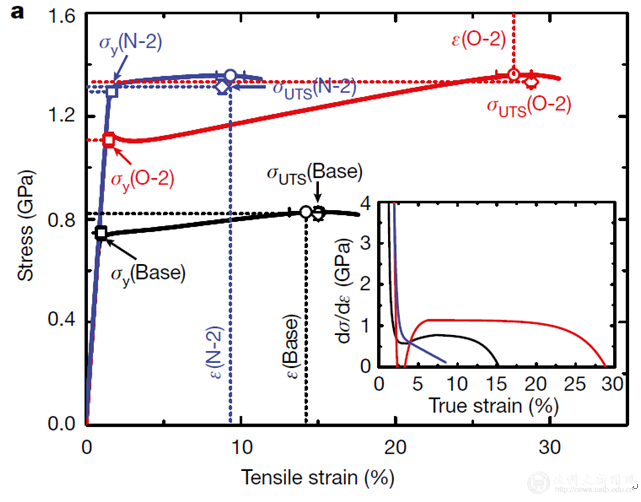Prof. Zhaoping Lu’s group, from the Beijing Advanced Innovation Center for Materials Genome Engineering, State Key Laboratory for Advanced Metals and Materials at USTB, reported an anomalous interstitial strengthening effect in a family of single-phase refractory high-entropy alloys (HEAs) at ambient temperature. In contrast to conventional interstitial strengthening, strength and ductility are both substantially improved (tensile strength by 57.6 % and ductility by 86.5 %) when doping the TiZrHfNb refractory HEA with 2.0 at. % oxygen. This unexpected finding breaks the paradigm of the strength-ductility trade-off via doping an inexpensive and ubiquitous element, and was published in Nature on 14th November, 2018.
Metallic alloys are backbone materials for manufacturing, construction, mobility and energy generation. Synthesis and processing of metallurgical products are inevitably accompanied by the introduction of impurities, particularly the omnipresent environmental oxygen. Once exceeding its solubility limit, oxygen usually forms hard phases, such as oxide particles, leading to drastic deterioration of mechanical properties, especially to the embrittlement and catastrophic failure of materials. Therefore, metallurgical processing principally aims at avoiding precipitation of brittle oxides and instead seeks significant strengthening from solute interstitials. Unfortunately, interstitial strengthening in traditional metals and alloys often comes at the expense of ductility. The embrittlement effects caused by interstitials can arise from segregation to grain boundaries or from accumulation at crack tips, dislocations and other sources of internal stresses. Such behavior can be related to the significant distortions of the host matrix at these microstructural sites, promoting local decohesion and inducing localized plastic fracture.
In contrast to the common wisdom, experimental and theoretical investigations by Prof. Zhaoping Lu’s group revealed that oxygen can take the form of ordered oxygen complexes (OOCs), a state in between oxide particles and commonly occurred random interstitials. Such OOCs lead to the unprecedented enhancement in both strength and ductility in these compositionally complex solid solutions, the so-called HEAs. More importantly, they found that this OOC-mediated strain-hardening mechanism is also applicable in Ti-, Zr- and Hf-containing alloys. This unique OOC-mediated strain-hardening mechanism is especially important to those alloys where tuning the stacking fault energy and thermomechanical treatments do not work for improving mechanical properties. These findings provide new insight into the role of interstitial solid solutions and associated ordering strengthening mechanisms in metallic materials.
